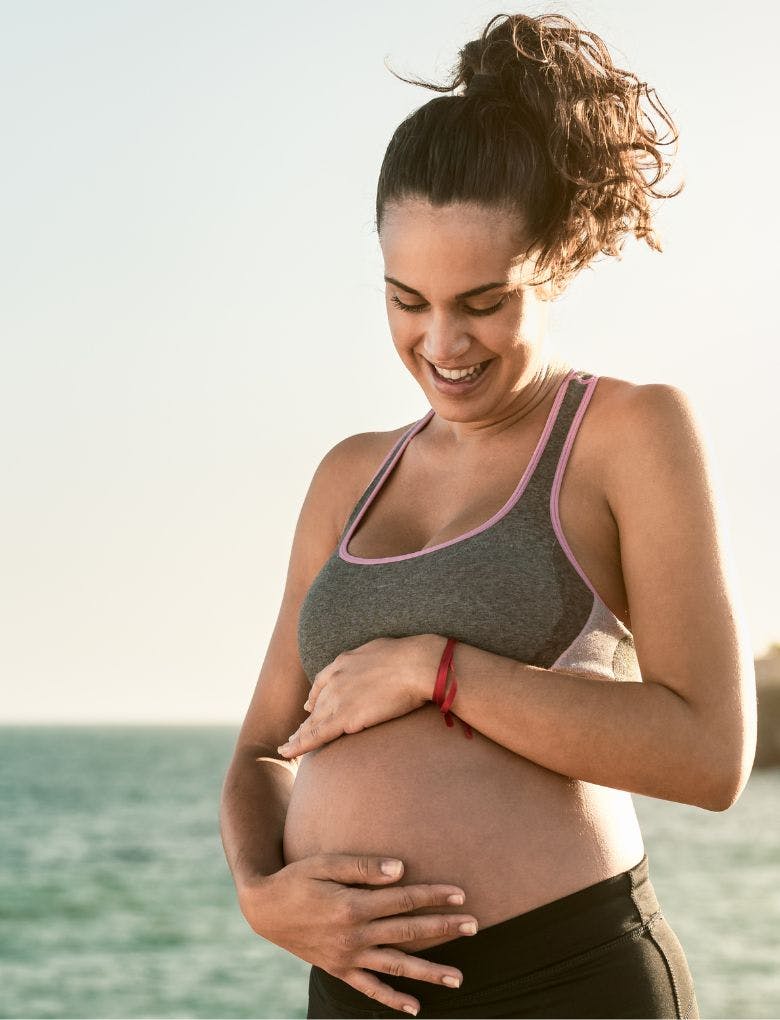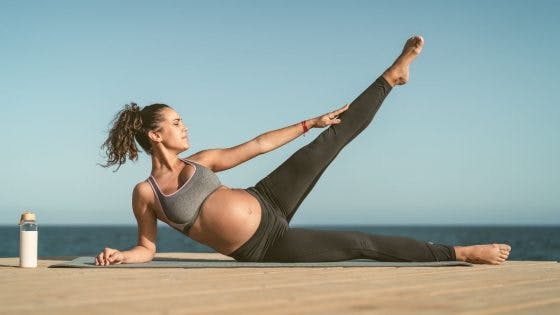Your Pregnancy Fitness Guide
9 minutes read
Pregnancy is a rollercoaster ride of emotions and a plethora of information to take in. However, what we can simplify is the approach to your pregnancy fitness. Of course, this is different for everyone, so you should be advised by your physician. However, if you get the green light from your healthcare providers, then read on to find out everything you need to know about exercising when pregnant. From the do’s and don’t to specific trimester advice and even breathing techniques and movements to de-bloat, de-puff and calm.
Triyoga Pregnancy Yoga teacher Grace Sisto reminds us, “Pregnant women have been treated for too long as physically impaired. However, in the last few decades, women have started reclaiming their need to keep up with their usual physical activities. This choice has helped them maintain or promote better physical and mental health throughout the transition to motherhood.
If you are used to a certain physical activity and have been doing it for an established length of time, your instructor or teacher is happy to accommodate you, and you haven’t been advised to stop by your care team, you should be able to carry on. Adopt necessary modifications and make listening to your body the highest priority – the key is not to find what you can and cannot do but rather trust your instinct to know what feels right and what doesn’t.”
To make the pregnancy wellness journey easier for you, Rosie Stockley, renowned Women’s Fitness Specialist founded Mamawell – A platform dedicated to helping women exercise with confidence throughout pregnancy, postpartum and beyond. With home fitness workouts for all levels, from cardio to yoga and mindfulness techniques, and nourishing recipes from the Mamawell kitchen.
She agrees: “The dialogue around exercise in pregnancy has changed over the last few years due to new studies and better available information. Women can now be more confident working out during their pregnancy. There are lots of encouraging positive advice available and some great programmes to follow that promote strength, cardio fitness, and some of the more sedate movements that many women had available in previous years.
In a ‘normal’ uncomplicated pregnancy, the NHS advises 150 minutes of moderate activity per week, and this can be broken up into as many sessions as is needed. It could include classes, running or just walking or being active around the home. Keeping fit during pregnancy has multiple benefits for the mother, including but not limited to:
- Regulating blood pressure and hormonal levels
- Reducing the risk of gestational diabetes
- Lessening the risk of aches and pains
- Helping with constipation
Also, keeping the muscles strong supports the body as it grows, helps with postural alignment, and with strength in the birth and the recovery afterwards.
Keeping cardiovascularly fit is excellent for general health; it helps to have the endurance for the birth and busy life when the baby is here.
Research has found that the size of the placenta was larger in those mothers who exercised – suggesting increased nutrients and oxygen delivery to the foetus, plus waste removal. (Jackson 1995, Clapp & Rizk 1992).”
Stockley says, “The Mamawell Method aims to empower women by educating them on their body’s adaptations in pregnancy and how movement can support this. Women want all the facts now – they don’t want to be told: ‘oh, you just have to accept that with childbirth’. The women that inspired The Mamawell Method told me they wanted to keep going with their regular workouts but with just a few tweaks to support them through this challenging life phase – both pre and postnatal.
They still want to sweat, feel the burn, feel challenged and look good, but they want quality information to back up their plan to feel confident and safe. The Mamawell Method comprises strength, cardio, abs work and stretching with lots of advice through the trimesters so women can adapt their workout to suit their energy levels and the point they’re at in their pregnancy.”
Read next: Pregnancy Skincare: What Ingredients To Avoid?
What about that fear of exercise? Especially when women may have suffered miscarriages or had difficulties conceiving?
“Fear is valid and shouldn’t be overlooked. It’s always a balance between what might make you feel good, such as your workouts and what could be detrimental. In the case of exercise, there isn’t research to say it shouldn’t be advised for these population groups. But women may feel better reducing the intensity of their workouts.
It’s essential to be in optimal health when trying to conceive, and this includes a healthy body fat ratio, ensuring hormonal levels are correct. So eating enough and not over-exercising is vital at this time. But normal exercise that utilises resistance training and cardio work is great for both body and mental health.
If you’re feeling fearful, I’d recommend seeking advice from pregnancy or a postnatal trained instructor who could help tailor your workouts and give you specialised support.”
What questions should you ask your Dr before pregnancy exercise?
“I would recommend getting your blood pressure checked by your GP and informing them of any medical issues you may have had prior.
Your midwife will be able to tell you about where your placenta is lying as this may impact how you exercise through your pregnancy.”

Trimester fitness
Grace Sistos’ Guide to Trimester Fitness Routines:
Trimester 1 – “This is the most delicate of trimesters as this is the time when most miscarriages take place. It is easy to attribute this unfortunate event to doing something wrong during physical activity. For this reason, most fitness classes and teachers would advise you to wait until the 12th week. However, if you are used to some form of gentle movement and this still feels good to do, keep doing it. This could also include a simple walk or gentle stretching.”
Trimester 2 – “After week 12, in many cases, women start to feel less lethargic, morning sickness might ease off, and you might feel more drawn to take up physical activities again. Many women feel quite energetic, and at the beginning of the 2nd trimester, the bump is not yet ‘getting in the way’, allowing for ease of movement. With all necessary prenatal adjustments, carrying on with your preferred activity is highly recommended. You are advised to stay away from high-impact and contact sports during pregnancy.”
Trimester 3 – “Much like the 2nd trimester, some women might experience high energy levels. However, these are more interspersed with days of tiredness, discomfort and general slower mobility. With the bump getting bigger, women will naturally avoid certain positions like lying on their front, deep twists or explosive movements, favouring more static variations of their preferred physical activity. There are always wide choices of modifications to accommodate pregnancy or any restrictions or ailments coming with it.”
Read next: Healthy Pregnancy Tips: Your Comprehensive Guide To Bump Beauty
The modern rules of pregnancy fitness
What exercises help with water retention? Swollen ankles and bloating?
“In yoga Viparita Karani (Legs up the wall) can be a nice pose to relieve swollen and tired legs. Although not an exercise, dry brushing is a great technique to address water retention.”
The benefits of pregnancy-friendly massages?
“Pregnancy massages, whether to relax or relieve any ailments, are a great way to pamper yourself, have a bit of downtime and promote relaxation. Osteopathy, reflexology and acupuncture to address specific conditions can also be very beneficial.”
Check out the pregnancy-specific treatment at a Clarins Spa near you. There’s also a Mum To Be Virtual Beauty Event – 16 June | 12:30PM
30-minutes, register your interest here
Tell us about the good breathing techniques for pregnancy to try:
“Many pranayama (breathing techniques) within the yoga teachings can benefit women during pregnancy. These should be practised with the safe guidance of a teacher. For example, Nadi shodhana (opposite nostril breathing) and bhramari pranayama (bee breath).”
What exercises should you avoid?
“During pregnancy, you are advised to stay away from high-impact and contact sports. Adapting how you perform specific exercises is the key—adapting to your changing body and the changing sensations. For example, someone experiencing nausea well into their 2nd trimester will not enjoy the same poses as a pregnant woman at the height of their trimester.
Closed twists, front lying positions and lying on your back for an extended period towards the end of 2nd/beginning of 3rd are usually not recommended. If you’re experiencing specific ailments such as pelvic girdle pain, balancing poses or any pose that requires the legs to move out to the side may aggravate the discomfort. It depends on you, your body and how you feel, so keep an open dialogue with your teacher/trainer, and they should give you the best adaptations that work best for you.
Avoid overstretching due to the relaxin hormone. Legs, arms and glutes are three body parts that can and should remain strong throughout pregnancy. Becoming familiar with the pelvic floor region and activating your deeper abdominal muscles during pregnancy will help keep the body functional during pregnancy and at the stage of recovery postpartum. Restorative yoga poses that are pregnancy-friendly are a fantastic way to promote relaxation, breath awareness, tapping into the parasympathetic nervous system.”
Do your limbs become more flexible when pregnant due to hormones?
“Your body produces a hormone called relaxin, responsible for loosening your ligaments and preparing your body for birth. Its powerful influence may increase flexibility throughout your body, especially in your joints. While this might seem desirable, exploiting your newfound flexibility can cause overstretching and increase the likelihood of injury – not the best way to care for a newborn! Stay within a safe range of motion and ensure your teacher or instructor knows how to ensure this for you.”
The bottom line is it might not actually be your decision to exercise and should always be a collaboration between you and your healthcare team.
TO FIND OUT MORE:
Triyoga
Grace Sisto teaches ‘Pregnancy Open’ yoga classes at Triyoga. Triyoga’ Pregnancy Open’ yoga classes are available Monday – Sunday at Triyoga Chelsea, Camden, Ealing, Shoreditch and online. Book online at triyoga.co.uk
Mamawell Method
A platform dedicated to helping women exercise with confidence throughout pregnancy, postpartum and beyond. With home fitness workouts for all levels, from cardio to yoga and mindfulness techniques, to nourishing recipes from the Mamawell kitchen. Click here
This article is not a substitute for professional medical advice, diagnosis, or treatment and should never be relied upon for specific medical advice – always consult a physician.

SPECIAL OFFER: Whether you’re expecting or have already welcomed your baby into the world, Clarins will help you feel beautiful with this gorgeous 4 piece kit and pouch when you spend £40. Offer available from 20th June – 31st December 2023. Click here for more information.
Read next: Your Complete Pregnancy Safe Self-Tan Guide
Sign up for our newsletter
We will keep you in the loop for special offers, exclusive gifts and product news.

